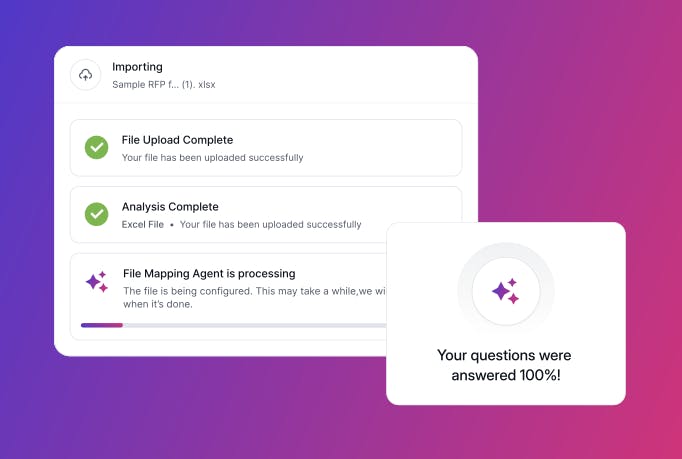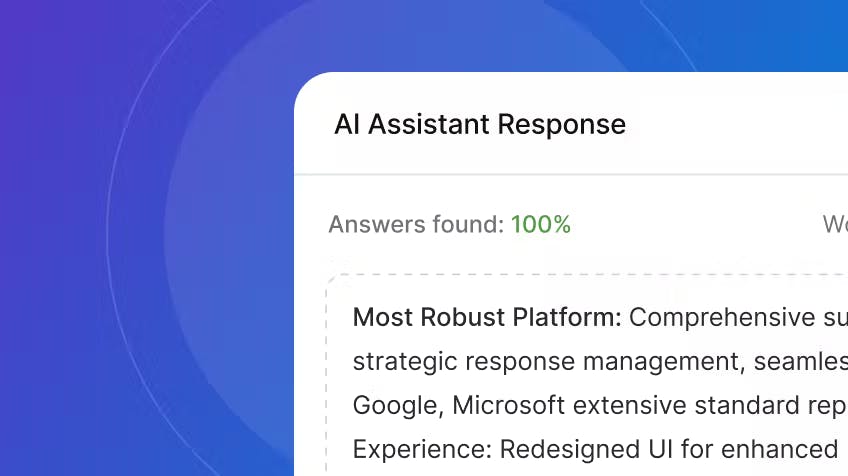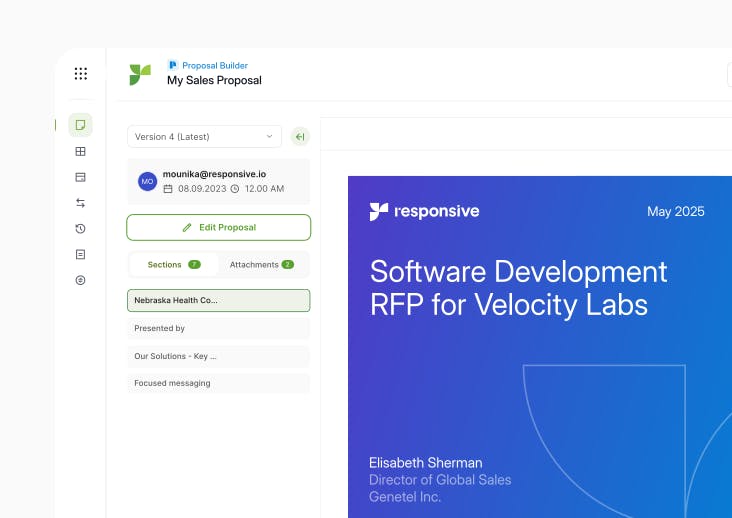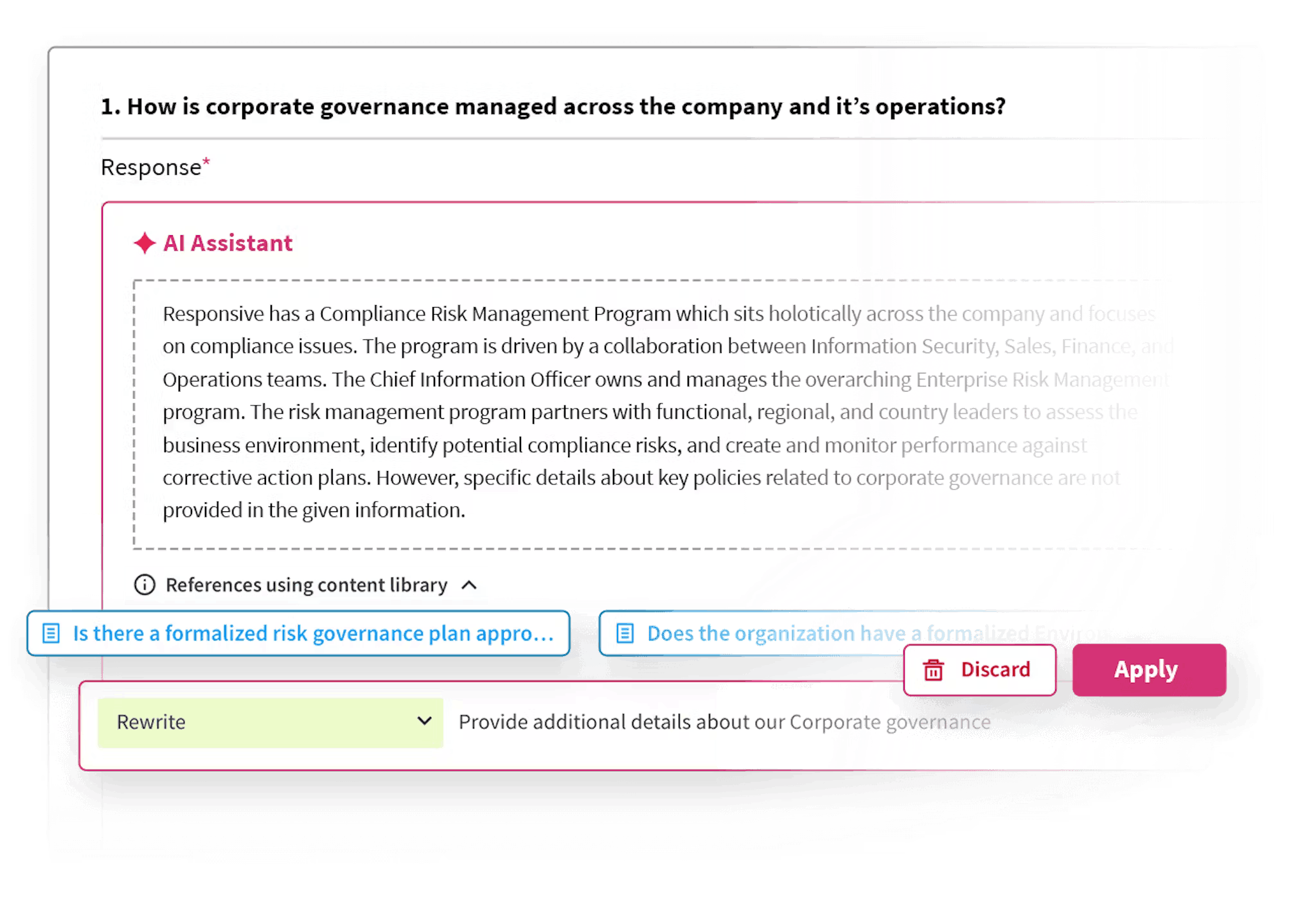Organizations responding to RFPs are increasingly turning to AI-powered solutions to streamline the process. However, even the most advanced AI agent requires clear, well-structured prompts to deliver high-quality, tailored responses. Understanding how to prompt an RFP agent effectively can transform the efficiency and accuracy of proposal development.
This guide explores the fundamental principles of prompting and how Responsive's AI Assistant can enhance the strategic response process.
RFP agents: The basics
An RFP agent is an advanced AI system designed to streamline the process of responding to RFPs by automating tasks such as document analysis, content generation, and compliance checks. By integrating with an organization's knowledge base, it ensures that responses are accurate, consistent, and tailored to specific requirements. This technology not only accelerates the RFP response process but also enhances the quality of proposals, allowing teams to focus on strategic decision-making and client engagement.
An RFP agent functions by leveraging AI to analyze and generate responses based on stored knowledge and user-provided context. The more structured the input, the more refined the output. For example, a vague prompt such as, "Describe our cybersecurity solutions," will yield a generic response. In contrast, a well-defined prompt specifying compliance standards, product features, and client benefits will generate a response that is both informative and compelling.
You can learn more about AI’s impact on RFP response workflows in How AI is Changing RFP Response and Management.

The fundamentals of effective prompting
When you craft a good prompt, you direct an AI agent to generate responses that are not only relevant but also aligned with the requirements of the RFP. Structuring prompts with a clear framework ensures the AI understands the nuances of what needs to be communicated.
While it may come as no surprise that clarity is essential, it's not always obvious what that entails. When you define what the AI should produce, specify the desired tone and include key details to ensure a more precise result. Strong examples can serve as reference points, which will also help the AI recognize and replicate high-quality responses.
Even with these efforts, you should still always plan to iterate. Testing and refining your prompts can significantly improve output over time, making your process more efficient and reliable.
Crafting the right prompts: A strategic approach
When crafting your prompts:
- Be specific about your request in order to eliminate ambiguity and provide AI with the necessary context to generate an appropriate response.
- Format your prompts in a structured manner, such as breaking down key points into separate instructions to help maintain coherence.
- Use reference material. It plays a critical role in ensuring consistency, and when you integrate content from your past successful responses, you improve alignment with your organizational messaging.
- Test different variations of your prompt to reveal the most effective wording and structure for optimal AI-generated results.
How to use Responsive's AI Assistant for prompting
Responsive's AI Assistant is designed to streamline your RFP response process. The following features enhance your RFP content:
Contextual prompting capabilities
Contextual prompting enables you to interpret and generate responses based on the specific requirements outlined in an RFP. By embedding essential details such as industry regulations, client priorities, and tone preferences, you can refine AI-generated responses to match proposal expectations.
Case studies highlighted in Introducing Responsive AI Agents showcase how teams from several global enterprise companies such as Microsoft, Netsmart, JAGGEAR, and others improved response accuracy by embedding key details into prompts, reducing the need for manual editing time.
AI-Powered content suggestions
When you use Responsive's AI-powered content suggestions, you can analyze previously approved responses and recommend the most relevant content based on the context of the RFP. This feature minimizes redundancy and enhances efficiency by pulling from stored knowledge, ensuring consistency across your responses.
For example, if your organization frequently responds to RFPs in the cybersecurity sector, the AI Assistant can automatically surface the most relevant responses related to compliance requirements, security protocols, and case studies. This reduces your need for manual retrieval of past content and ensures your messaging remains aligned with your company's strategic priorities. You can learn more about AI-powered content suggestions on page 25 of The AI Handbook for Strategic Response Management.

Integration with the Content Library
The Content Library ensures that your AI-generated responses align with your company's pre-approved messaging and compliance requirements. When you prompt the AI Assistant, it references stored information to generate responses that adhere to your corporate guidelines.
For instance, if you work at a financial services company responding to compliance-related RFPs, you can maintain regulatory consistency by integrating AI with your content library. This approach reduces risks associated with manual errors and ensures your responses meet industry standards.
Automated formatting & style compliance
When you use AI-powered formatting tools, you standardize responses, ensuring they adhere to the required structure, style, and word count constraints. It's not just about aesthetics — although that's an added benefit — this also reduces time you spend manually adjusting content and improves the professionalism of your submissions.
How to Write a Tender with AI further highlights how AI-assisted formatting streamlines your RFP process, enabling many procurement teams to cut their response time in half.
Common prompting pitfalls to avoid
Though AI-driven assistance can dramatically boost your response efficiency, it works best when guided properly. If you're not careful with how you set up your prompts, you might run into common problems that result in off-target, inconsistent, or mismatched responses. When you understand these potential stumbling blocks — and know how to work around them — you can fine-tune your AI-assisted processes and consistently produce higher-quality submissions that consistently deliver.
Forgetting to specify tone & style
When your AI-generated responses miss the mark on tone and style preferences, they can feel generic or misaligned with your brand messaging. To prevent this, clearly instruct your AI on whether the tone should be formal, conversational, or technical, ensuring consistency across responses. Another helpful way to ensure you cover this is to include your company's Brand Style Guidelines if that is something available to you.
Not considering the Content Library
Without referencing your established Content Library, your AI responses may lack alignment with previously approved messaging. You should ensure that your AI pulls content from a central repository to maintain compliance and brand consistency. By integrating AI with your Content Library, you will improve response accuracy and reduce manual edits.

Prompting without considering the RFP type
When you respond to different types of RFPs, you need different levels of detail. We'll go into more detail on this below but, for example, when you respond to a government RFP, you may need extensive regulatory compliance, while a corporate bid may prioritize value propositions. Structuring your AI prompts to reflect the specific request type ensures your responses meet requirements.
Failing to use the AI's regeneration & editing features
You shouldn't accept AI-generated content at face value. Leverage AI's regeneration features to refine responses, test variations, and ensure content is clear and compliant. When you iteratively improve AI-generated responses, you create stronger submissions.
Not reviewing AI outputs for compliance & accuracy
Though AI can generate your responses efficiently, your manual review is essential to ensure accuracy. Automated checks for compliance are helpful, but human validation is necessary to catch nuanced errors. When you review AI-generated responses before submission, you ensure content is both precise and properly formatted.
Thanks to AI-powered workflow automation, your subject matter experts (SMEs) can be automatically assigned to review and sign off on applicable sections, ensuring your process moves forward smoothly without the hindrance of bottlenecks or any confusion regarding roles and responsibilities.
Misunderstanding what the buyer is asking for
When you fail to interpret the buyer's intent, you risk creating off-target responses that weaken your proposal. To ensure alignment, you should extract key evaluation criteria from the RFP before prompting AI.
You'll notice buyers often outline explicit scoring rubrics or emphasize priorities in the introduction, requirements, or compliance sections. For example, if an RFP for cloud-based software highlights data security and compliance, your AI-generated responses should focus on SOC 2 certification, encryption standards, and access controls rather than general product features.
Instead of prompting AI with broad requests like:
- "Explain our security policies"
You should refine your input to be more specific:
- "Generate a 150-word response detailing our SOC 2 compliance, end-to-end encryption, and access control policies, emphasizing alignment with financial services regulations."
When you leverage past RFP responses stored in the Content Library, you can prevent misalignment by ensuring consistency in tone, detail, and compliance language. You should always review and refine AI-generated content before submission, using Responsive Academy's AI training resources to improve output quality. Your SMEs should validate responses to confirm accuracy and adherence to compliance standards.
By structuring your prompts around buyer priorities and iterating on AI-generated content, you'll produce proposals that are more relevant, competitive, and aligned with scoring criteria.
Failing to include win themes & differentiators
Your AI-generated responses can fall short in persuasion if they do not emphasize your organization's unique strengths. Without your clear guidance, AI may produce technically correct but generic answers that fail to stand out.
To enhance competitiveness, your prompts should direct AI to incorporate key win themes such as innovation, cost savings, superior customer support, or industry expertise.
Avoid simple prompts like:
- "Describe our implementation process"
A more strategic approach would be:
- "Describe our implementation process with a focus on our dedicated onboarding specialists, 24/7 support, and 30% faster deployment compared to industry standards."
These more specific prompts ensure your AI-generated responses are both informative and compelling.
You should also embed customer success stories and proof points to strengthen credibility. You can prompt AI to reference past performance metrics, client testimonials, or real-world use cases that demonstrate measurable impact. If an RFP asks about scalability, your well-structured prompt might be, "Explain how our platform scales for enterprise clients, using a case study of a Fortune 500 company that increased efficiency by 40% after implementation."
By integrating concrete differentiators and real-world results, your responses not only stand out as unique, they also become more persuasive and aligned with buyer priorities.
Overlooking the technical depth needed for IT & Engineering RFPs
For your IT and engineering proposals, AI-generated responses must go beyond surface-level explanations to deliver the depth and precision expected by technical evaluators. If your prompts lack specificity, AI may generate responses that are too high-level, failing to address key technical details that decision-makers prioritize.
To ensure accuracy, you should provide AI with clear instructions that incorporate industry-specific terminology, relevant frameworks, and precise technical specifications.
For example, rather than prompting AI with:
- "Describe our cloud security measures"
Use a more effective prompt like:
- "Explain our cloud security architecture, including encryption methods, access control mechanisms, and compliance with SOC 2 and ISO 27001 standards."
This level of detail ensures that your AI-generated responses align with the technical depth required in IT and engineering RFPs.
Additionally, you can guide AI to structure responses in a way that mirrors how technical teams evaluate proposals. Many IT and engineering RFPs follow structured formats that require explanations of system architecture, integration capabilities, scalability, and performance benchmarks.
Your well-crafted prompt might say, "Detail our API integration capabilities, including supported authentication protocols, data exchange formats, and real-time processing limits."
By embedding these technical expectations within your prompt, your AI-generated content will better meet the buyer's requirements and reflect the depth of expertise necessary to stand out in competitive IT and engineering RFPs.
Applying AI to different types of requests

Requests for Information (RFIs)
When you use AI for responding to RFIs, you can effectively provide high-level overviews of your capabilities, helping buyers assess vendor suitability without requiring detailed, structured responses like in RFPs. To ensure your AI-generated content meets these expectations, you should structure prompts to highlight company strengths, competitive differentiators, and technical expertise.
A generic response may fail to showcase your organization's unique value, so it is essential to guide AI toward emphasizing key advantages.
For instance, instead of simple prompts like:
- "Describe our company's capabilities"
Use a more effective approach like:
- "Provide a concise summary of our cloud-based security solutions, focusing on compliance certifications, AI-driven automation, and scalability for enterprise clients."
By framing your prompts in this way, your AI-generated responses can align more closely with the requestor's evaluation criteria.
Additionally, when you respond to RFIs that span multiple industries, you'll need to tailor responses based on the specific sector and business needs of the requestor. Your well-structured prompt should specify which product lines or service offerings should be emphasized, ensuring AI does not generate a one-size-fits-all response.
If the requestor is in the healthcare industry, for example, your prompt should direct AI to highlight HIPAA compliance and data protection measures, whereas an RFI from a financial services company may require a focus on regulatory compliance and fraud prevention tools.
By fine-tuning your AI prompts to reflect industry-specific priorities, you can generate responses that are not only accurate but also compelling. Find more helpful strategies on optimizing AI-generated responses for procurement inquiries in How to Write a Bid with AI.
Requests for Quotes (RFQs)
When you respond to RFQs, pricing accuracy is critical, as buyers are prioritizing clear and precise financial information over detailed technical capabilities. You can use AI to generate structured responses that outline pricing models, cost breakdowns, and standard terms, ensuring that your responses are both comprehensive and easy to evaluate.
To maximize effectiveness, your prompts should guide AI to align responses with your organization's pricing strategy and procurement best practices.
Instead of a broad prompt like:
- "Provide pricing details"
Use a more strategic approach like:
- "Generate a cost breakdown for our enterprise software package, including per-user licensing fees, volume discounts, and annual maintenance costs."
By framing your prompts with specificity, you will produce structured, buyer-friendly responses that improve clarity and transparency in your RFQ submissions.
Additionally, you can direct AI to reference historical pricing data to maintain consistency across your RFQ responses while ensuring compliance with standard procurement requirements. Buyers often expect pricing details to follow a specific format, and you can prompt AI to generate responses that align with these expectations.
For instance, your well-crafted prompt might instruct AI to "Format the pricing response in a table that includes unit costs, bulk pricing options, and implementation fees, ensuring alignment with past approved quotes." This approach minimizes discrepancies and streamlines the procurement review process.
Security Questionnaires & Due Diligence Questionnaires (DDQs)
Security questionnaires and DDQs require precise, compliance-driven responses to demonstrate your organization's ability to meet regulatory and security standards. Unlike general RFPs, they demand structured answers that directly address risk management and legal obligations.
You can use AI to streamline this process by pulling verified responses from your Content Library, ensuring consistency and reducing errors. However, generic AI-generated responses may lack the necessary specificity to satisfy compliance officers. To improve accuracy, your prompts should direct AI to use pre-approved security statements and align with company policies.
Instead of asking:
- "Explain our approach to data security”
Use a stronger prompt like:
- "Provide a response on our encryption practices, referencing SOC 2 and ISO 27001 compliance."
This ensures your responses meet industry expectations and regulatory requirements.
You can also tailor AI to incorporate the security frameworks most relevant to the requestor's industry. Some organizations prioritize GDPR compliance, while others require adherence to HIPAA, NIST, or FedRAMP standards. By specifying the appropriate framework, your AI-generated responses become more relevant to the buyer's security concerns.
For example, if you're creating a financial institution's DDQ response, you should emphasize data encryption, fraud prevention, and third-party risk management, while a healthcare-related questionnaire should highlight HIPAA compliance and patient data protection.
When you align AI-generated content with the requestor's specific compliance priorities, you improve efficiency while maintaining the accuracy and credibility needed for security assessments.
Tenders & Bids
Tenders and bids require structured, highly detailed responses that align with the buyer’s evaluation criteria. Unlike standard RFPs, they also come with strict formatting requirements, word limits, and compliance rules, making precision essential. AI can be used to structure responses to match submission guidelines, ensuring key sections — such as scope of work, technical details, and pricing — are comprehensive and properly formatted.
Without clear prompting, your AI-generated responses may lack depth or fail to emphasize competitive advantages. To improve response quality, instruct AI to reference specific evaluation criteria from the tender document so responses directly address scoring methodology.
Instead of a broad prompt like:
- "Describe our service capabilities"
Use a stronger approach like:
- "Outline our service capabilities, focusing on efficiency gains, ISO 9001 compliance, and recent successful tender projects."
This targeted method ensures your responses meet both technical and competitive requirements.
Beyond compliance and formatting, your tenders and bids must clearly differentiate your organization from competitors. You can use AI to highlight key win themes such as innovation, cost-effectiveness, or superior customer support.
By instructing AI to incorporate success metrics, case studies, or industry expertise, you strengthen persuasiveness. If sustainability is a buyer priority, your prompt could specify, "Detail our sustainability initiatives, including carbon reduction strategies and ESG compliance."
When you align AI-generated responses with buyer priorities and evaluation criteria, you help your organization submit stronger, more competitive tenders that stand out.
Sales Proposals & Pitches
AI enhances sales proposal efficiency by tailoring responses to customer needs and emphasizing value propositions. Unlike RFPs, these proposals require a persuasive, customer-centric approach that highlights competitive advantages and solution benefits.
You can use AI to structure responses that directly address buyer priorities, but your prompts must guide it to focus on specific customer challenges rather than producing generic content.
In place of a vague prompt like:
- "Describe our software's capabilities"
A stronger approach would be:
- "Highlight how our AI-driven analytics platform reduces manual reporting time by 40%, improves data accuracy, and integrates with enterprise tools."
This ensures your proposals are solution-oriented and relevant to the prospect's business needs.
You can also use AI to refine persuasive messaging by aligning proposals with customer pain points and industry-specific concerns. By instructing AI to emphasize scalability, ROI, or efficiency gains, you can generate personalized, impactful responses.
If a prospect prioritizes scalability, your prompt might be, "Explain how our cloud infrastructure supports rapid expansion, using a Fortune 500 case study." You can also use AI to maintain branding and tone consistency, ensuring alignment with past successful proposals.
FAQs about prompting an RFP agent
When you prompt an RFP agent effectively, you need a clear understanding of how AI interprets and generates responses. Here are seven common questions and best practices to help ensure accuracy, consistency, and alignment with buyer expectations when working with your RFP agent.
How do I phrase a prompt to get the most accurate response from an RFP agent?
To get the most precise response, make your prompts specific, structured, and include relevant context. For instance, rather than asking, "Explain our cloud security measures," a better prompt would be, "Describe our cloud security features, including encryption, compliance with GDPR, and threat monitoring."
This ensures your AI-generated responses are detailed and relevant. You can find more insights in How LLMs Work in SRM.

What's the difference between a good prompt and a bad one?
Good prompts:
- Give specific, clear instructions with well-defined goals
- Establish appropriate context including who the audience is and why it matters
- Clearly outline what structure and format you want for the response
- Include essential details that point the AI in the right direction
- Specify the industry or audience so responses feel personally relevant
- Incorporate your unique selling points and competitive advantages
- Set practical boundaries like word count or presentation style
- Provide helpful examples that show what success looks like
- Mention specific data, metrics, or results you want highlighted
- Connect to your existing content standards or previous successful work
Poor prompts:
- Use fuzzy, general requests that lack clear direction
- Miss important details about who will read the response and why
- Leave format and structure requirements unstated
- Skip mentioning key details that would guide better answers
- Forget to include what makes your offerings special
- Allow unlimited scope, leading to rambling or unfocused content
- Provide no examples of what you're looking for
- Miss chances to showcase what sets you apart from competitors
- Use generic wording that could apply to any business
- Overlook important technical or compliance requirements
Can I train an RFP agent to improve its responses over time?
Yes, by refining prompts and leveraging AI's iterative learning capabilities, you can improve response quality. When you consistently use structured templates and keep the Content Library updated, you ensure AI aligns with your evolving messaging needs while generating more precise, relevant answers.
Of course, the quality of input you provide directly determines how effectively the system performs, which is why training it with well-crafted, high-performing examples is so important. By incorporating specific contextual instructions and clear parameters, you establish a framework that guides the AI toward increasingly valuable outputs for your team.
Additionally, you'll find AI's effectiveness improves when you integrate best practices from strategic response management (SRM) and ensure responses reflect current compliance, industry trends, and buyer preferences. The AI Handbook for Strategic Response Management provides insights into optimizing AI-driven content, while How LLMs Work in SRM explains how large language models refine responses based on structured data.
What if my RFP agent gives me an incorrect or incomplete response?
- Refine your prompts by adding specific details or requesting several variations
- Use AI's regeneration and editing capabilities to gradually enhance content quality
- Break complex prompts into smaller, focused queries for more precise answers
- Reference pre-approved content from the Content Library to maintain alignment with company standards and compliance requirements
Tips for establishing a continuous improvement process:
- Regularly review AI-generated content to identify patterns and opportunities
- Gather feedback from SMEs to refine approach
- Constantly iterate on prompt structures based on performance
- Maintain a systematic approach to ensure your RFP agent delivers increasingly accurate responses over time
How do I ensure consistency across multiple RFP responses?
To maintain uniformity across multiple RFP responses, you should rely on the Content Library and predefined style guidelines to ensure consistency in tone, formatting, and compliance. Your AI-generated responses should align with previously approved language and messaging, preventing inconsistencies that could weaken a proposal.
When you instruct AI to reference past high-scoring responses and adhere to company branding, you ensure a seamless, professional approach. This also allows you to leverage structured templates to reinforce uniform formatting which reduces time spent on manual revisions. For more tips and insights on RFP templates, check out Proposal templates, formats and tools: Create better RFP responses faster.
How does Responsive's AI Assistant differ from generic AI chatbots?
Unlike generic AI tools, Responsive's AI Assistant is purpose-built specifically for Strategic Response Management (SRM). This specialized design ensures your responses align with industry best practices, compliance standards, and company-approved content.
While general AI chatbots produce broad, unstructured content, Responsive's AI Assistant integrates with your Content Library, compliance tools, and structured workflows to deliver:
- Context-aware responses tailored to specific RFPs
- Accurate content based on your approved messaging
- Reusable materials that maintain consistency across submissions
The Responsive AI Assistant is engineered to understand complex procurement requirements and adapt to buyer-specific needs, industry terminology, and regulatory frameworks. Instead of relying on open-ended language generation like standard AI models, it applies structured learning techniques that refine responses over time, with each iteration improving accuracy.
For deeper understanding, the AI Handbook for Strategic Response Management offers insights into how AI-driven SRM enhances efficiency and compliance. Additionally, How LLMs Work in SRM explains the technical differences in how these large language models process structured RFP data compared to conventional chatbots.
By combining domain-specific AI capabilities with workflow automation and continuous content refinement, you and your team gain a meaningful competitive edge over traditional approaches in the RFP response process.
How can I ensure AI maintains quality while helping me complete my RFPs?
AI can accelerate your response process by pulling from pre-approved content, applying compliance standards, and adapting language to fit buyer expectations, but your human oversight and validation remains essential. To maintain accuracy, you should use content governance practices, including regularly updating the Content Library and refining AI-generated responses based on SME review.
How AI processes structured data has a major impact on response quality, too. Unlike generic AI models, Responsive's AI Assistant leverages historical response data, compliance frameworks, and industry-specific terminology to ensure your responses align with best practices in SRM; this includes consideration of past high-scoring responses and ensuring consistency and alignment with buyer evaluation criteria.
By combining AI-driven efficiency with SME oversight and structured content governance, you can confidently accelerate RFP completion without sacrificing quality, accuracy, or compliance.
Mastering prompting for smarter responses
Mastering the art of prompting is an ongoing process, but with the right techniques, your AI-generated responses can be more efficient, accurate, and strategically aligned. By experimenting with different approaches and leveraging Responsive's AI Assistant, you can significantly enhance your ability to craft compelling and high-quality RFP responses.
To get started, explore Responsive’s AI capabilities and take advantage of all the information shared in The AI Handbook for Strategic Response Management.
